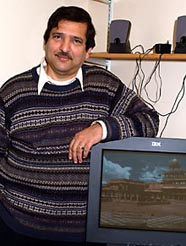Mudur's 3D world: Professor sees shape of the world in his research

Sudhir Mudur is working to compress 3D files so they can be easily shared on the Internet
Ryan Blau
When Professor Sudhir Mudur joined Concordia’s computer science department, he left behind the familiar world of Bombay, India, where he had studied and worked all his life. But he can still visit computerized models of the Taj Mahal and Fatehpur Sikri (a 16th century abandoned city near Delhi). Computational problems and issues related to large three-dimensional models such as these are his main research interest.
Three-dimensional computer models are becoming increasingly common in engineering, architecture, medical imaging, simulations, heritage site documentation, and the entertainment industry. But the amount of data involved may be huge, depending on the shape of the object. A 3D scanner reads the object’s surface as small polygons – generally triangles – and hundreds of millions of polygons may be required.
Mudur is exploring ways of compressing files so this data can be shared on the Internet more easily. He does this by developing software that looks for shapes that repeat. Different methods are required to find repetitive features in engineered objects, such as buildings and helicopters, and in natural objects, which feature many tiny details. “My research has approached both of these techniques,” he says.
Before coming to Concordia, Mudur was director of the National Centre for Software Technology in Bombay, India. He met several Concordia faculty members when they visited the institute. He did not want to spend the rest of his career in administration, so when he was invited to teach a summer course in Montreal, he accepted. “I liked Montreal and I felt Concordia would give me sufficient academic freedom to do what I wanted to do,” he says. “And there was an opportunity to build up a new research group in my area of three-dimensional graphics.” He and his wife and family moved here in January, 2002.
He has made a lot of progress since then, laying the groundwork for his research. With a start-up grant from the dean, he bought some graphics workstations, which he put in two rooms. He has also received NSERC operating and equipment grants. He has recently been given a larger room to house this equipment, and is in the process of ordering 3D scanners that are big enough to scan a person.
A proposal to the Canada Foundation for Innovation has also been approved. This grant will allow Mudur and collaborators Thomas Fevens and Dhrubajyoti Goswami to purchase more equipment, which will be ordered as soon as more space is allotted. This state-of-the-art lab will use a cluster of 16 computers, working in parallel, to handle the data processing required for large, digitized worlds.
Mudur has lined up a total of four PhD and 12 masters-level students so far, some of whom are under joint supervision with other faculty members. He is collaborating with colleagues in the computer science department in a variety of projects in addition to the parallel computer cluster. For example, he plans to work with Nematollaah Shiri and someone from Environment Canada, using visualization techniques to identify patterns in data from 30 years of weather observations. The goal is to predict short-range weather conditions, especially at airports, with greater accuracy.
In another project, he and Juergen Rilling intend to create a three-dimensional visualization of a very large software program. They want to find out whether this helps people who are not familiar with the program to understand it more easily.
He points out that the main theme underlying these and other collaborations is the visualization of large amounts of data in order to better understand the information and solve problems. “We have just initiated these projects, and do not have great results to report yet,” Mudur says, but he is confident they are off to a good start.